Cryogenic Vessels Market Size
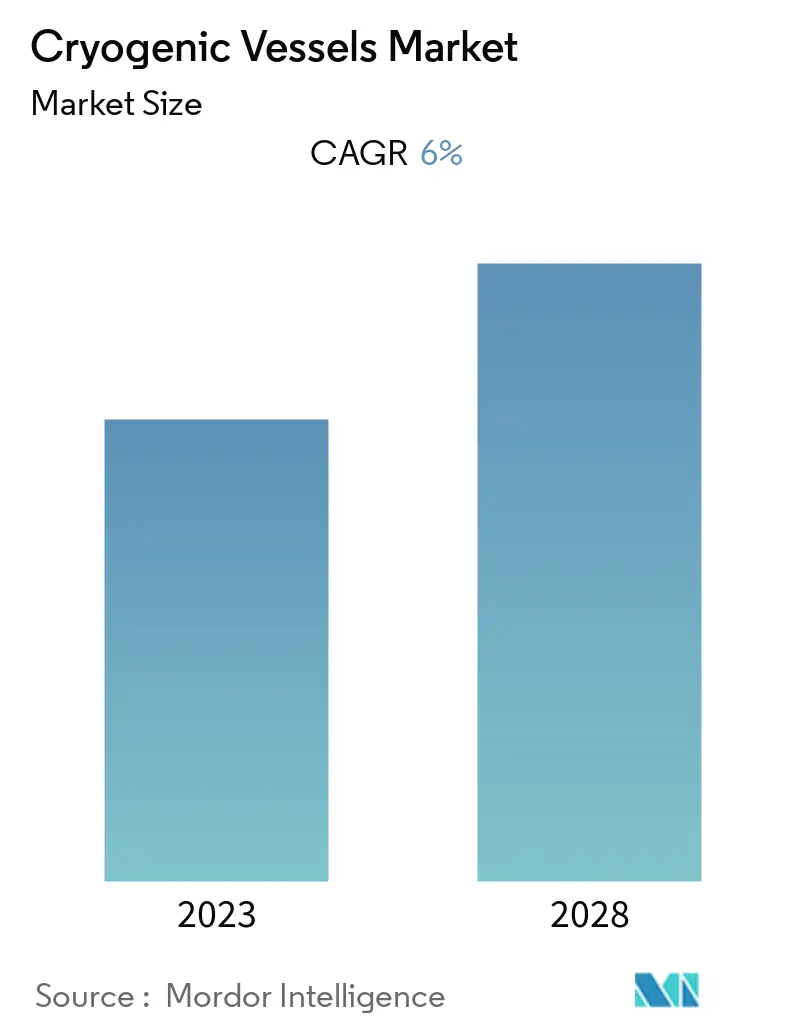
| Study Period | 2019-2028 |
| Base Year For Estimation | 2022 |
| CAGR | 6.00 % |
| Fastest Growing Market | Asia Pacific |
| Largest Market | North America |
| Market Concentration | Medium |
Major Players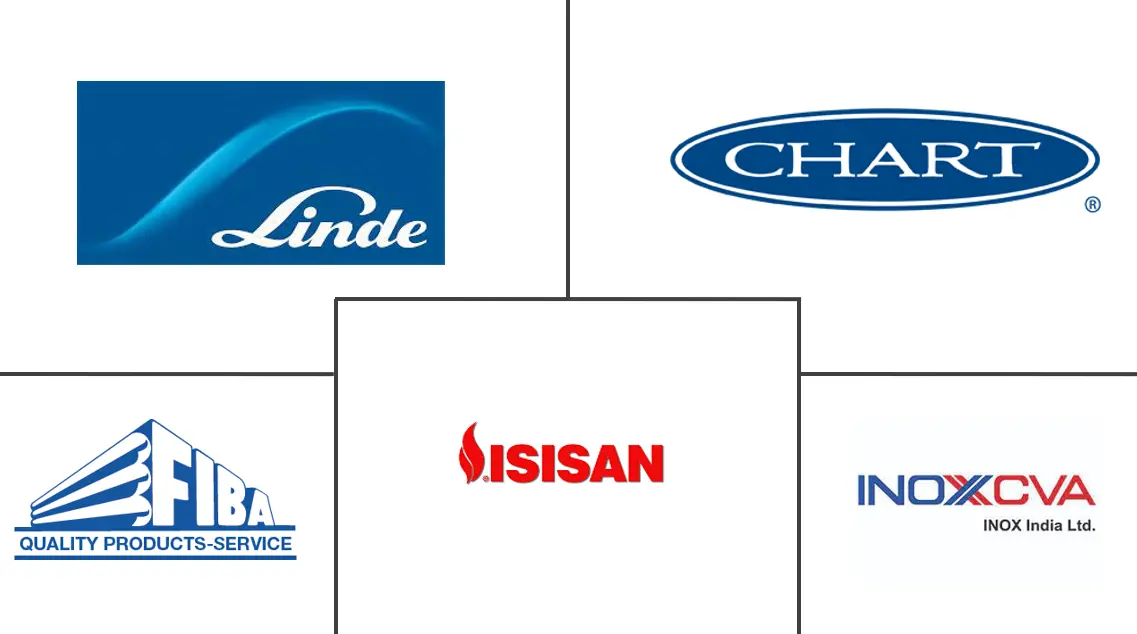
*Disclaimer: Major Players sorted in no particular order |
Need a report that reflects how COVID-19 has impacted this market and its growth?
Cryogenic Vessels Market Analysis
The cryogenic vessel market is projected to register a CAGR of 6% during the forecast period.
COVID-19 negatively impacted the market in 2020. Presently, the market has reached pre-pandemic levels.
- Over the medium term, the increasing demand for liquefied natural gas (LNG) and increasing investments in developing healthcare systems are expected to increase the demand for cryogenic vessels during the forecasted period.
- On the other hand, high operations and maintenance costs are expected to hinder market growth.
- Nevertheless, the increasing technological investments in cryogenic energy storage system development and the increasing deployment of hydrogen as an energy source are expected to create huge opportunities for the cryogenic vessel market.
- Asia-Pacific is expected to dominate the market during the forecasted period due to the increasing demand for liquefied natural gas for energy generation.
Cryogenic Vessels Market Trends
Metal Processing Industry To Dominate The Market
- Cryogenic vessels have significant applications in the metal industry due to their ability to handle and store materials at extremely low temperatures. These vessels are utilized in various ways to enhance metal processing and manufacturing processes.
- In metalworking, cryogenic vessels are used to achieve ultra-low temperatures by circulating liquid nitrogen or other cryogenic fluids. This rapid cooling process improves metals' hardness, strength, and wear resistance. Cryogenic treatment, cryogenic machining, and cryogenic grinding are some of the processes that benefit from this technique.
- Furthermore, cryogenic vessels play a significant role in metal fabrication and welding operations. Cryogenic gases, such as liquid nitrogen or argon, are stored in these vessels as shielding gases during welding processes. By preventing oxidation and providing a controlled environment, these cryogenic gases enhance the quality of welds.
- Furthermore, the metal industry has observed growth in recent years and is expected to continue during the forecasted period due to urbanization, infrastructure development, population growth, and industrial expansion.
- For instance, in September 2022, Nippon Steel Corp. and ArcelorMittal revealed their plans to make an additional investment to expand steel production capacity in India. The Japanese company, the largest steelmaker globally, will construct and expand blast furnaces and associated facilities. Additionally, they are anticipated to acquire port and electric power companies in India as part of their expansion strategy. With this investment, the annual production of crude steel is projected to rise from 9 million tons to 15 million tons by the first half of 2026.
- According to the World Steel Association, in 2022, 188,5026 thousand tons of steel were produced globally, which was more than 3% of the steel production in 2018.
- In summary, the growth of the metal industry is likely to increase the utilization of cryogenic vessels due to the expanding adoption of advanced manufacturing techniques, the demand for improved material performance, and the need for cryogenic gases in fabrication and welding operations.
- Therefore, per the above-mentioned points, the metal industry is expected to dominate the market.
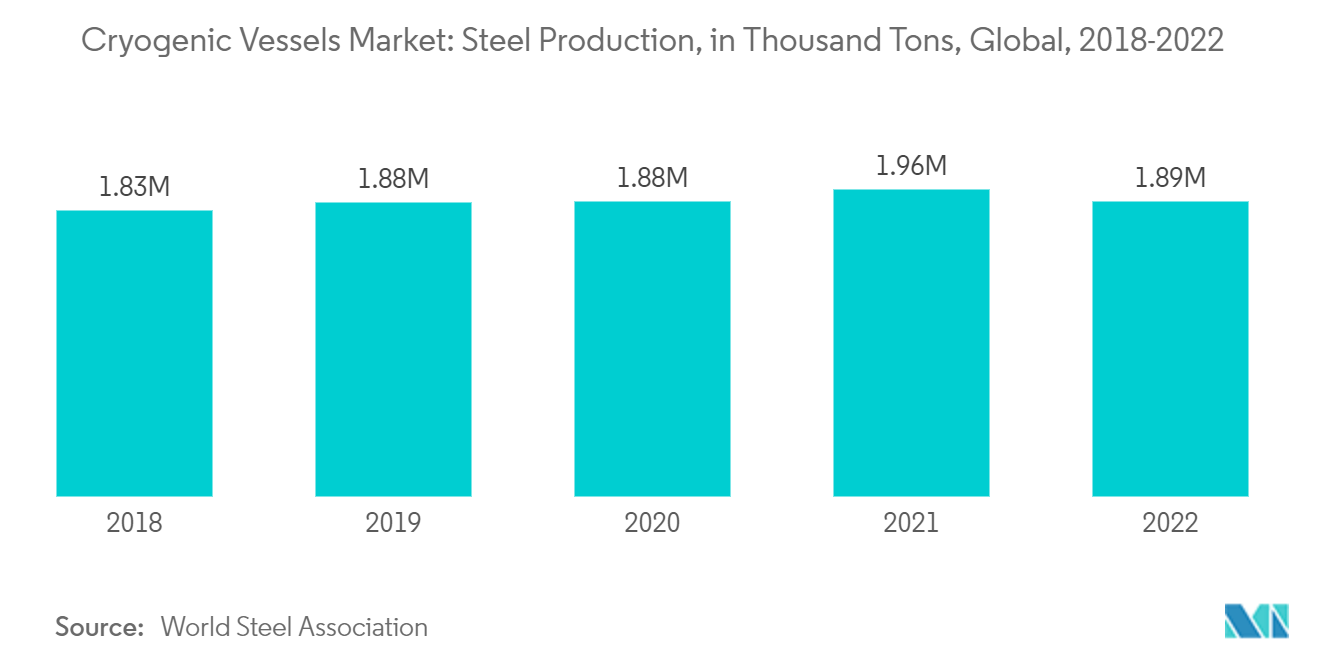
Asia-Pacific to Witness Significant Growth
- Due to several significant factors, the Asia-Pacific region is poised to experience increased demand for cryogenic vessels. One key driver is the region's rapid industrialization across various sectors, including energy, chemicals, electronics, and healthcare. As these industries require cryogenic fluids and processes, the demand for cryogenic vessels for storage and transportation is expected to rise.
- Furthermore, Asia-Pacific's expanding healthcare and medical research sectors contribute to the increased need for cryogenic vessels. These vessels play a vital role in storing and transporting biological samples, vaccines, and other temperature-sensitive materials, ensuring their integrity at ultra-low temperatures.
- Another key factor is the region's focus on energy and power infrastructure development. With significant investments in liquefied natural gas (LNG) terminals and storage facilities, the demand for cryogenic vessels for LNG storage and transportation is expected to surge.
- For instance, in January 2022, the Malaysian State of Sabah and Petronas announced plans for a two million metric tons per year (mmt) liquefied natural gas (LNG) terminal. The new facility planned for the Sipitang Oil and Gas Industrial Park is part of Petronas’ collaboration with the state to expand Sabah’s distribution of cleaner energy to industrial and commercial businesses.
- Furthermore, due to increasing energy demand, natural gas consumption in the region has been on the rise in recent years. According to the BP statistical review of world energy 2022, natural gas consumption in 2021 was 918.3 bcm, an increase of 6.2% compared to 2020 and a 4% annual growth rate between 2011 and 2021.
- In summary, the Asia-Pacific region is anticipated to see an increase in demand for cryogenic vessels due to its rapid industrialization, expanding healthcare and medical research sectors, energy and power infrastructure development, growth in aerospace and defense applications, as well as its focus on technological advancements and research.
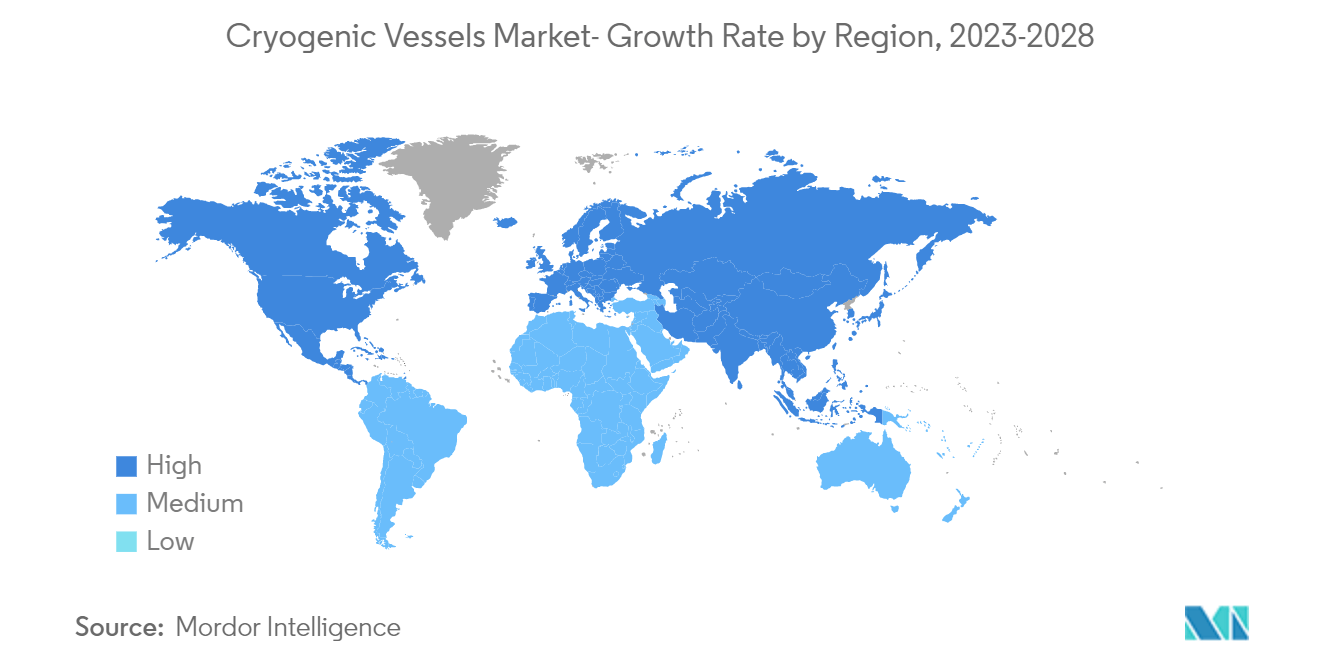
Cryogenic Vessels Industry Overview
The global cryogenic vessels market is moderately fragmented. Some key players in this market (in no particular order) include Linde plc, Chart Industries Inc, Inox India Ltd, Isisan AS, and FIBA Technologies Inc.
Cryogenic Vessels Market Leaders
Linde plc
Chart Industries Inc
Inox India Ltd
Isisan AS
FIBA Technologies Inc
*Disclaimer: Major Players sorted in no particular order
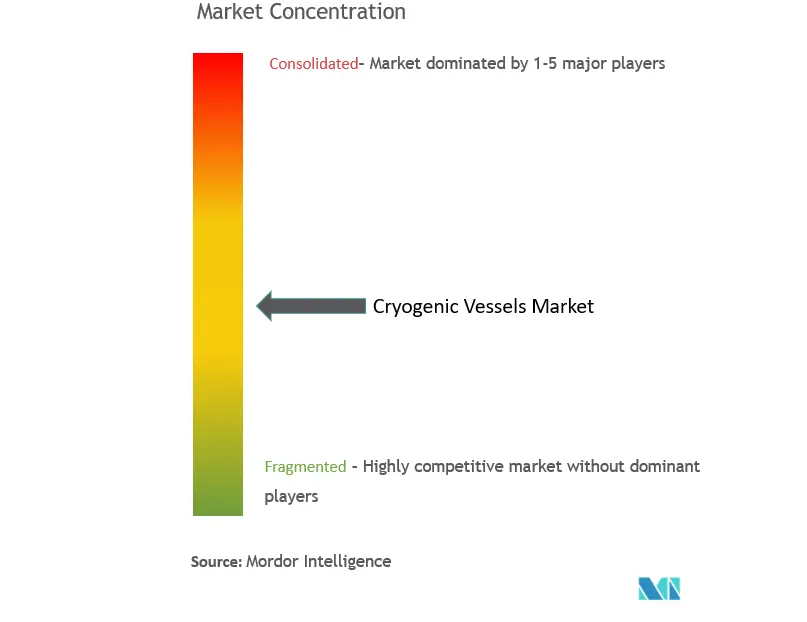
Cryogenic Vessels Market News
- April 2023: The National Composites Centre (NCC), located in Bristol, U.K., unveiled a program dedicated to testing composite cryogenic storage tanks within the United Kingdom. This initiative aims to validate and expedite the capabilities to design, manufacture, and test such tanks. The program is projected to evaluate a linerless carbon fiber tank that stores liquid hydrogen (LH2).
- March 2023: INOXCVA, a provider of solutions for cryogenic liquid storage, distribution, and re-gasification, commenced the development of its new manufacturing facility in Savli, Vadodara, Gujarat. Spanning 30 acres, this green-field project is set to become India's largest manufacturing facility for cryogenic equipment. The facility can fabricate over 20,000 metric tons per year with its advanced capabilities.
Table of Contents
1. INTRODUCTION
1.1 Scope of the Study
1.2 Market Definition
1.3 Study Assumptions
2. EXECUTIVE SUMMARY
3. RESEARCH METHODOLOGY
4. MARKET OVERVIEW
4.1 Introduction
4.2 Market Size and Demand Forecasts in USD billion, till 2028
4.3 Recent Trends and Developments
4.4 Government Policies and Regulations
4.5 Market Dynamics
4.5.1 Drivers
4.5.2 Restraints
4.6 Supply Chain Analysis
4.7 Industry Attractiveness - Porter's Five Forces Analysis
4.7.1 Bargaining Power of Suppliers
4.7.2 Bargaining Power of Consumers
4.7.3 Threat of New Entrants
4.7.4 Threat of Substitutes Products and Services
4.7.5 Intensity of Competitive Rivalry
5. MARKET SEGMENTATION
5.1 Application
5.1.1 Storage
5.1.2 Transport
5.2 End-User Industry
5.2.1 Energy Generation
5.2.2 Metal Processing
5.2.3 Healthcare
5.2.4 Food and Beverages
5.2.5 Other End-User Industries
5.3 Cryogenic Liquid
5.3.1 LNG
5.3.2 Liquid Nitrogen
5.3.3 Liquid Oxygen
5.3.4 Liquid Hydrogen
5.3.5 Other Cryogenic Liquids
5.4 Raw Material
5.4.1 Steel
5.4.2 Nickel Alloy
5.4.3 Aluminum Alloy
5.4.4 Other Raw Materials
5.5 Geography [Market Size and Demand Forecast till 2028 (for regions only)]
5.5.1 North America
5.5.1.1 United States
5.5.1.2 Canada
5.5.1.3 Rest of North America
5.5.2 Europe
5.5.2.1 Germany
5.5.2.2 France
5.5.2.3 United Kingdom
5.5.2.4 Russia
5.5.2.5 Rest of Europe
5.5.3 Asia-Pacific
5.5.3.1 China
5.5.3.2 India
5.5.3.3 Australia
5.5.3.4 Japan
5.5.3.5 Malaysia
5.5.3.6 Rest of Asia-Pacific
5.5.4 Middle East and Africa
5.5.4.1 Saudi Arabia
5.5.4.2 UAE
5.5.4.3 Nigeria
5.5.4.4 South Africa
5.5.4.5 Rest of Middle East and Africa
5.5.5 South America
5.5.5.1 Brazil
5.5.5.2 Argentina
5.5.5.3 Chile
5.5.5.4 Rest of South America
6. COMPETITIVE LANDSCAPE
6.1 Mergers and Acquisitions, Joint Ventures, Collaborations, and Agreements
6.2 Strategies Adopted by Leading Players
6.3 Company Profiles
6.3.1 Linde PLC
6.3.2 Air Water Inc
6.3.3 Chart Industries Inc
6.3.4 Cryofab Inc
6.3.5 Cryolor
6.3.6 FIBA Technologies, Inc.
6.3.7 INOX India Ltd.
6.3.8 ISISAN A.S
6.3.9 Wessington Cryogenics
6.3.10 Gardner Cryogenic
- *List Not Exhaustive
7. MARKET OPPORTUNITIES AND FUTURE TRENDS
Cryogenic Vessels Industry Segmentation
Cryogenic vessels are containers designed to store and transport materials at very low temperatures, typically below -150°C (-238°F). These vessels are used to store and transport liquefied gases such as nitrogen, oxygen, argon, helium, and hydrogen, which are commonly used in various industrial, medical, and scientific applications.
The cryogenic vessels market is segmented by application, end-user industry, cryogenic liquid, raw material, and geography (North America, Asia-Pacific, Europe, South America, the Middle East, and Africa). By application, the market is segmented into storage and transport. The end-user industry segments the market into energy generation, metal processing, healthcare, food and beverages, and others. The market is segmented by cryogenic liquid: LNG, liquid nitrogen, liquid oxygen, liquid hydrogen, and others. The market is segmented by raw material into steel, nickel alloy, aluminum alloy, and others. The report also covers the market size and forecasts for the cryogenic vessel market across major regions, such as Asia-Pacific, North America, Europe, South America, the Middle East, and Africa. Market sizing and forecasts have been done for each segment based on revenue (USD billion).
| Application | |
| Storage | |
| Transport |
| End-User Industry | |
| Energy Generation | |
| Metal Processing | |
| Healthcare | |
| Food and Beverages | |
| Other End-User Industries |
| Cryogenic Liquid | |
| LNG | |
| Liquid Nitrogen | |
| Liquid Oxygen | |
| Liquid Hydrogen | |
| Other Cryogenic Liquids |
| Raw Material | |
| Steel | |
| Nickel Alloy | |
| Aluminum Alloy | |
| Other Raw Materials |
| Geography [Market Size and Demand Forecast till 2028 (for regions only)] | ||||||||
| ||||||||
| ||||||||
| ||||||||
| ||||||||
|
Frequently Asked Questions
What is the current Cryogenic Vessels Market size?
The Cryogenic Vessels Market is projected to register a CAGR of 6% during the forecast period (2023-2028).
Who are the key players in Cryogenic Vessels Market?
Linde plc, Chart Industries Inc, Inox India Ltd, Isisan AS and FIBA Technologies Inc are the major companies operating in the Cryogenic Vessels Market.
Which is the fastest growing region in Cryogenic Vessels Market?
Asia Pacific is estimated to grow at the highest CAGR over the forecast period (2023-2028).
Which region has the biggest share in Cryogenic Vessels Market?
In 2023, the North America accounts for the largest market share in the Cryogenic Vessels Market.
Cryogenic Vessels Industry Report
Statistics for the 2023 Cryogenic Vessels market share, size and revenue growth rate, created by Mordor Intelligence™ Industry Reports. Cryogenic Vessels analysis includes a market forecast outlook to for 2023 to 2028 and historical overview. Get a sample of this industry analysis as a free report PDF download.
